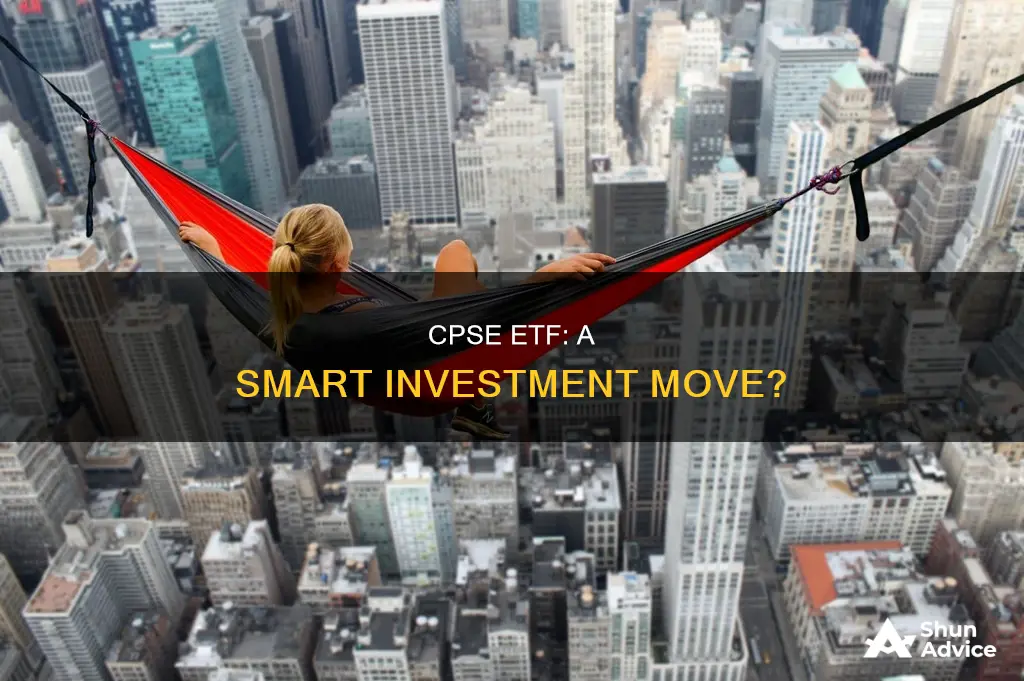
The Central Public Sector Enterprises Exchange-Traded Fund (CPSE ETF) is an investment fund that offers individuals the opportunity to invest in a diversified portfolio of public sector companies, providing exposure to various sectors and industries. The fund's performance is linked to the Nifty CPSE Index, which consists of 11 units of central public sector enterprises. CPSE ETFs are known for their liquidity, transparency, and ease of trading, making them an attractive option for long-term capital appreciation. With no lock-in period, CPSE ETFs provide flexibility for investors. However, it's important to assess the risks, consider the investment horizon, and analyse market conditions before investing. While CPSE ETFs have shown mixed historical performance, their low expense ratios and potential tax benefits make them a viable option for investors looking to enter the stock market.
What You'll Learn

Pros and cons of investing in CPSE ETF
Pros of Investing in CPSE ETF
- Diversification: CPSE ETFs offer investors a basket of stocks from various Central Public Sector Enterprises (CPSEs), spanning diverse sectors such as energy, banking, finance, power, and more. This diversification reduces the risk associated with investing in a single company and helps mitigate the impact of volatility in individual stocks.
- Low Expense Ratios and Cost-Effectiveness: As passively managed funds, CPSE ETFs aim to replicate the performance of a specific index without frequent buying and selling of assets. This passive management style results in lower management fees and expenses compared to actively managed funds. The low expense ratios make CPSE ETFs a cost-effective investment option, allowing investors to retain a larger portion of their returns.
- Liquidity and Tradability: CPSE ETFs are traded on stock exchanges, providing investors with liquidity. Unlike traditional mutual funds, investors can buy or sell CPSE ETF units on the exchange at prevailing market prices during trading hours. This flexibility allows investors to enter or exit their positions whenever they desire without being subject to lock-in periods.
- Potential for Stable Returns Over the Long Term: CPSE ETFs are composed of shares from established and well-known CPSEs, which often have a track record of stable performance and may distribute regular dividends. Over time, these ETFs have the potential to generate stable returns, especially when the underlying CPSEs perform well.
- Attractive Investment Avenue: CPSE ETFs offer investors an attractive opportunity to participate in India's growing public sector enterprises. The funds are well-suited for investors seeking long-term growth with moderate risk and a balanced approach to risk management.
Cons of Investing in CPSE ETFs
- Market Risks and Volatility: CPSE ETFs, like any stock market investment, are exposed to market risks and fluctuations. The value of CPSE ETF units can rise or fall based on market conditions, and investors should consider their risk tolerance before investing.
- Sector-Specific Risks: CPSE ETFs consist of stocks from various sectors, and the performance of these sectors can vary based on industry-specific factors. For example, the energy sector's performance might be influenced by fluctuations in crude oil prices. Investors should be cautious about concentrating their investments in a single sector and should instead diversify across different sectors to mitigate this risk.
- Government Policies and Regulatory Risks: Government policies and regulations can significantly impact CPSE ETF stocks. Decisions related to disinvestment, privatisation, or changes in sector-specific policies can affect the performance of the underlying CPSEs and, consequently, the ETF's returns. Changes in tax laws or investment regulations could also impact the taxation of capital gains on ETF units.
- Performance Influenced by Underlying CPSEs: The performance of CPSE ETFs is directly linked to the performance of the underlying CPSEs. Factors affecting the public sector, such as government policies, economic conditions, and sector-specific performance, can impact the ETF's returns.
A Simple Guide to Investing in SBI Nifty 50 ETF
You may want to see also

CPSE ETF's performance and potential returns
CPSE ETFs have demonstrated strong performance, delivering 77% returns in 2023 and making it the best-performing domestic fund for that year. Since its inception, CPSE ETF has delivered 11.12% returns.
The performance of CPSE ETFs is closely tied to the performance of the underlying CPSE stocks, which are government-owned companies playing a crucial role in India's economy. The fund's objective is to generate returns that correspond to the total returns of the securities represented by the CPSE Index.
CPSE ETFs offer potential for stable long-term returns, particularly when the underlying CPSEs perform well. The companies included in the ETF's portfolio are well-established and have a substantial presence in the Indian economy, with diverse sectors such as energy, banking, finance, power, and more.
The government's continued stake in CPSE ETFs and its commitment to promoting the growth and profitability of these public-sector enterprises provide confidence in the fund's long-term prospects. The government's disinvestment and public sector reforms also create opportunities for value unlocking.
However, investors should be cautious of the risks associated with CPSE ETFs. The performance of the fund can be influenced by market conditions, sector-specific risks, government policies, interest rates, inflation, and global events. Due diligence and risk management are crucial before investing in CPSE ETFs.
Ally Invest: Fee-Free ETFs and Their Benefits
You may want to see also

How to invest in CPSE ETF
The Central Public Sector Enterprises Exchange-Traded Fund (CPSE ETF) is a passive investment fund with no lock-in period. The CPSE ETF is based on the Nifty CPSE index and includes 11 listed Central Public Sector Enterprises. The fund seeks to provide returns that closely correspond to the total returns of the securities represented by the CPSE Index.
You can buy mutual funds directly from the website of the fund house. For example, the CPSE ETF fund can be purchased from the Nippon India Mutual Fund website. You can also use platforms like MF Central and MF Utility. If you are uncomfortable buying mutual funds online, you can seek help from a mutual fund distributor, such as a bank.
CPSE ETF can also be bought with a Demat trading account, similar to normal exchange-traded funds. HDFC Securities offers multiple trading platforms that can be used for investing in CPSE ETF.
AI ETF Investment: Strategies for Success
You may want to see also

CPSE ETF's risk profile
The CPSE ETF (Central Public Sector Enterprises Exchange-Traded Fund) is an initiative by the Government of India to divest its shareholding in select CPSEs through the ETF route. The fund is mandated to invest at least 80% of its assets in the shares of public sector companies and is passively managed, replicating the portfolio of its chosen benchmark index.
While the CPSE ETF has delivered strong returns, with an 11.12% return since its inception over 9 years ago, and a stellar performance in 2023, delivering 77% returns, it is considered a very high-risk investment. This is due to its narrowly defined investment mandate, with investments mainly in the shares of government-owned companies.
The CPSE ETF is based on the Nifty CPSE index and includes 11 listed Central Public Sector Enterprises. Its top holdings include the Oil & Natural Gas Corporation and the Power Grid Corporation of India. The fund has a conservative investment strategy, with most holdings in Large Cap stocks and debt instruments.
Given the high-risk nature of the CPSE ETF, investors are warned not to invest in this or any other PSU fund if they need to redeem their investment in less than five years.
ETFs: The Future of Passive Investing?
You may want to see also

CPSE ETF's tax implications
When considering investing in CPSE ETFs, it is important to understand the associated tax implications. Here is an overview:
Short-Term Capital Gains (STCG)
If you sell your CPSE ETF units within one year of purchasing them, your gains are considered STCG and are taxed at a flat rate of 15%.
Long-Term Capital Gains (LTCG)
If you sell your CPSE ETF units after one year of purchasing them and your gains exceed Rs. 1 lakh, they are considered LTCG and are taxed at a rate of 10% without indexation.
Dividends
CPSE ETFs may also distribute dividends, which are tax-free for investors. However, the fund house deducts Dividend Distribution Tax (DDT) before distributing the dividends.
Tax-Saving Investments
It is important to note that CPSE ETFs do not qualify for tax savings under Section 80C of the Income Tax Act. They are considered regular equity investments.
Lock-in Period and Tax Deductions
The government has offered an investment option in CPSE ETFs with a lock-in period of three years, similar to Equity Linked Savings Schemes (ELSS). Investments made in CPSE ETFs are eligible for tax deductions of up to Rs. 1.5 lakh under Section 80C of the Income Tax Act.
Consult a Tax Advisor
It is always advisable to consult a tax advisor or financial expert to understand the specific tax implications based on your individual financial situation.
A Simple Guide to STI ETF Investment
You may want to see also
Frequently asked questions
CPSE stands for Central Public Sector Enterprises Exchange Traded Fund. It is a passive investment fund with no lock-in period that was created to help the Government of India divest its shareholding in select CPSEs (Central Public Sector Enterprises) through the ETF (exchange-traded fund) route.
CPSE ETFs offer investors the opportunity to invest in a diversified portfolio of public sector companies, providing exposure to various sectors and industries. It also offers liquidity, transparency, and ease of trading, making it an attractive option for those seeking long-term capital appreciation.
As per SEBI's latest guidelines, investment in the CPSE ETF comes under the Very High-risk category. It is important to assess your risk tolerance and consider your investment horizon before investing.
CPSE ETF can be bought directly from the website of the fund house, such as Nippon India Mutual Fund. You can also invest through platforms like MF Central and MF Utility, or through a mutual fund distributor, including most banks.







